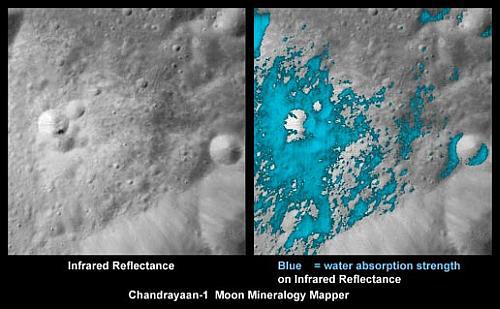Water on Moon exposed by Chandrayaan I
By Think Positive, Get Positive on 12:26:00 PM
Filed Under: discovery by ChandrayaanI, water on the Moon
Water on Moon exposed by Chandrayaan

In a landmark discovery, India’s maiden moon mission Chandrayaan-I has found evidence of water on the lunar surface, a finding that could trigger a serious hunt for life in outer space.
In a major leap for India’s space programme, the Moon Mapper on board the Indian space probe made the unexpected discovery that water may still be forming on the moon surface, overturning the long accepted view that lunar soil is dry.
There are strong chemical signatures of water on the moon in its high latitudes, said Carle Pieters, Principal Investigator of Nasa’s Moon Mineralogy Mapper (M3) instrument. Chandrayaan-I, whose mission also included sniffing for water on Earth’s only natural satellite, had made the discovery before it was prematurely aborted on August 30.
Isro scientists J N Goswami and Mylswamy Annadurai, who made key contributions to the study, were ecstatic about the findings which could unleash another round of moon missions.
“Our baby has done its job,” Annadurai, Project Director for Chandrayaan-I, said by phone from Bangalore.
Pieters published her findings in the latest issue of Science where she said that M3 results show presence of small amounts of water on the uppermost surface of the moon.
While the mangnitude was not known, scientists believe a tonne of lunar soil could fetch about a litre of water. “If it weren’t for them, we wouldn’t have been able to make this discovery,” Pieters said, crediting Isro for its role in the findings.
Isro Chairman G Madhavan Nair said in Bangalore the discovery was “path-breaking”, saying no lunar odyssey so far had given a “positive” conclusion.
“There is confirmation of traces of water.It is a path-breaking event as far as Chandrayaan-I mission is concerned. It is very, very significant. So far, no mission has confirmed the presence of water positively,” Nair said.
M3 was one of the 11 instruments onboard Chandrayaan-I, which was launched on October 22 last year. The mission had to be ended abruptly after the spacecraft lost contact with the ground station.
Until now, scientists had advanced the theory that there might be ice at the permamently dark bottom of craters at the Moon’s poles but the rest of the Moon was totally dry. Now, the finding ends four-decade long speculation on whether there is water on the moon.
Scientists said the discovery could refocus interest in the moon. The appeal waned after astronauts visited 40 years ago and called it “magnificent desolation”.
Scientists first claimed that water existed on the moon about 40 years ago, after they analysed rock samples brought to earth as souvenirs by Apollo astronauts. But they had doubts about the findings, as the boxes in which the moon rocks were brought to earth had leaked, contaminating the samples with air from the atmosphere.
Scientists believe water could have been formed due to interaction of oxygen present in rocks and soil on the moon with hydrogen in the form of protons emitted by the sun as a result of nuclear fusion.
Pieters’ team found water molecules and hydroxyl at diverse areas of the sunlit region of the moon’s surface, but the water signature appeared stronger at higher latitudes.
The M3 discovery was confirmed by data from two NASA spacecraft — the Visual and Infrared Mapping Spectrometer on the Cassini spacecraft and the High-Resolution Infrared Imaging Spectrometer on the EPOXI spacecraft. Data from those missions also are being published in separate papers in Science.
The M3 instrument analysed how sunlight reflected off the lunar surface to identify water particles in which scientists observed elements of chemical bonding similar to water. However, the instrument can only see the very uppermost layers of the lunar soil — perhaps to a few centimetres below the surface. Data received from Nasa’s M3 was supplemented by observations of the Isro payloads Hyper-Spectral Imager (HySI) and Moon Impact Probe (MIP).

0 comments for this post